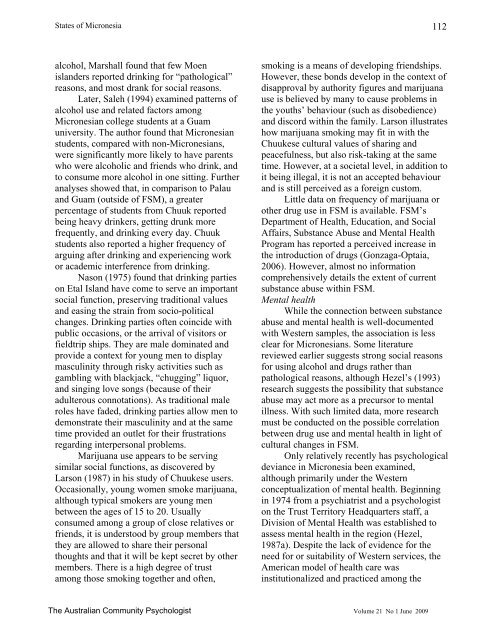issue 1 09 - APS Member Groups - Australian Psychological Society
issue 1 09 - APS Member Groups - Australian Psychological Society
issue 1 09 - APS Member Groups - Australian Psychological Society
You also want an ePaper? Increase the reach of your titles
YUMPU automatically turns print PDFs into web optimized ePapers that Google loves.
States of Micronesia112alcohol, Marshall found that few Moenislanders reported drinking for “pathological”reasons, and most drank for social reasons.Later, Saleh (1994) examined patterns ofalcohol use and related factors amongMicronesian college students at a Guamuniversity. The author found that Micronesianstudents, compared with non-Micronesians,were significantly more likely to have parentswho were alcoholic and friends who drink, andto consume more alcohol in one sitting. Furtheranalyses showed that, in comparison to Palauand Guam (outside of FSM), a greaterpercentage of students from Chuuk reportedbeing heavy drinkers, getting drunk morefrequently, and drinking every day. Chuukstudents also reported a higher frequency ofarguing after drinking and experiencing workor academic interference from drinking.Nason (1975) found that drinking partieson Etal Island have come to serve an importantsocial function, preserving traditional valuesand easing the strain from socio-politicalchanges. Drinking parties often coincide withpublic occasions, or the arrival of visitors orfieldtrip ships. They are male dominated andprovide a context for young men to displaymasculinity through risky activities such asgambling with blackjack, “chugging” liquor,and singing love songs (because of theiradulterous connotations). As traditional maleroles have faded, drinking parties allow men todemonstrate their masculinity and at the sametime provided an outlet for their frustrationsregarding interpersonal problems.Marijuana use appears to be servingsimilar social functions, as discovered byLarson (1987) in his study of Chuukese users.Occasionally, young women smoke marijuana,although typical smokers are young menbetween the ages of 15 to 20. Usuallyconsumed among a group of close relatives orfriends, it is understood by group members thatthey are allowed to share their personalthoughts and that it will be kept secret by othermembers. There is a high degree of trustamong those smoking together and often,smoking is a means of developing friendships.However, these bonds develop in the context ofdisapproval by authority figures and marijuanause is believed by many to cause problems inthe youths’ behaviour (such as disobedience)and discord within the family. Larson illustrateshow marijuana smoking may fit in with theChuukese cultural values of sharing andpeacefulness, but also risk-taking at the sametime. However, at a societal level, in addition toit being illegal, it is not an accepted behaviourand is still perceived as a foreign custom.Little data on frequency of marijuana orother drug use in FSM is available. FSM’sDepartment of Health, Education, and SocialAffairs, Substance Abuse and Mental HealthProgram has reported a perceived increase inthe introduction of drugs (Gonzaga-Optaia,2006). However, almost no informationcomprehensively details the extent of currentsubstance abuse within FSM.Mental healthWhile the connection between substanceabuse and mental health is well-documentedwith Western samples, the association is lessclear for Micronesians. Some literaturereviewed earlier suggests strong social reasonsfor using alcohol and drugs rather thanpathological reasons, although Hezel’s (1993)research suggests the possibility that substanceabuse may act more as a precursor to mentalillness. With such limited data, more researchmust be conducted on the possible correlationbetween drug use and mental health in light ofcultural changes in FSM.Only relatively recently has psychologicaldeviance in Micronesia been examined,although primarily under the Westernconceptualization of mental health. Beginningin 1974 from a psychiatrist and a psychologiston the Trust Territory Headquarters staff, aDivision of Mental Health was established toassess mental health in the region (Hezel,1987a). Despite the lack of evidence for theneed for or suitability of Western services, theAmerican model of health care wasinstitutionalized and practiced among theThe <strong>Australian</strong> Community Psychologist Volume 21 No 1 June 20<strong>09</strong>
















